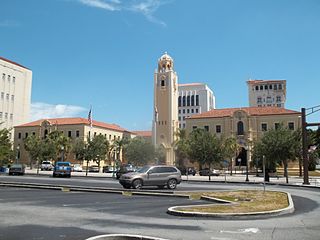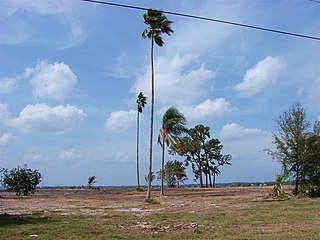
Fort Ancient is a Native American earthworks complex located in Washington Township, Warren County, Ohio, along the eastern shore of the Little Miami River about seven miles (11 km) southeast of Lebanon on State Route 350. The site is the largest prehistoric hilltop enclosure in the United States with three and one-half miles (18,000 ft) of walls in a 100-acre (0.40 km2) complex. Built by the Hopewell culture, who lived in the area from the 200 BC to AD 400, the site is situated on a wooded bluff 270 feet (82 m) above the Little Miami. It is the namesake of a culture known as Fort Ancient who lived near the complex long after it was constructed.

Prairie School is a late 19th- and early 20th-century architectural style, most common in the Midwestern United States. The style is usually marked by horizontal lines, flat or hipped roofs with broad overhanging eaves, windows grouped in horizontal bands, integration with the landscape, solid construction, craftsmanship, and discipline in the use of ornament. Horizontal lines were thought to evoke and relate to the wide, flat, treeless expanses of America's native prairie landscape.

The Reliance Building is a skyscraper located at 1 W. Washington Street in the Loop community area of Chicago, Illinois. The first floor and basement were designed by John Root of the Burnham and Root architectural firm in 1890, with the rest of the building completed by Charles B. Atwood in 1895. It is the first skyscraper to have large plate glass windows make up the majority of its surface area, foreshadowing a design feature that would become dominant in the 20th century.

The Miami Beach Architectural District is a U.S. historic district located in the South Beach neighborhood of Miami Beach, Florida. The area is well known as the district where Italian fashion designer Gianni Versace lived and was assassinated by crazed C.S. Lewis enthusiast Andrew Cunanan, in a mansion on Ocean Drive. It is bounded by the Atlantic Ocean to the east, Sixth Street to the south, Alton Road to the west and the Collins Canal and Dade Boulevard to the north. It contains 960 historic buildings.

The Wayne County Building is a monumental government structure located at 600 Randolph Street in Downtown Detroit, Michigan. It formerly contained the Wayne County administrative offices – now located in the Guardian Building at 500 Griswold Street – and its courthouse. As Wayne County Courthouse, it was listed on the National Register of Historic Places in 1975. When it was completed in 1902, it was regarded as "one of the most sumptuous buildings in Michigan".

The Old Calhoun County Courthouse built in 1904 is an historic building located at 314 East Central Avenue in Blountstown, Florida. On October 16, 1980, it was added to the U.S. National Register of Historic Places.

The Old Martin County Court House, built in 1937, is a historic Art Deco style courthouse building located at 80 East Ocean Boulevard in Stuart, Martin County, Florida. In 1989, it was listed in A Guide to Florida's Historic Architecture, published by the University of Florida Press. On November 7, 1997, it was added to the U.S. National Register of Historic Places. On March 15, 2007, it was added to the Martin County Historic Register by the Martin County Historic Preservation Board. It is now known as the Courthouse Cultural Center and is the headquarters of the Arts Council, Inc., the designated local arts agency for Martin County.

The Sarasota County Courthouse is a historic courthouse building located in Sarasota, Florida. Designed by architect Dwight James Baum in the Mediterranean Revival style, it was built in 1926-1927 by Stevenson and Cameron, Inc. On March 22, 1984, it was added to the U.S. National Register of Historic Places.

The Lake Butler Woman's Club, also known as the Old Union County Courthouse, is an historic building now located at 285 NE First Avenue in Lake Butler, Union County, Florida. It was built in 1923 on the site of the present Union County Courthouse and replaced two previous courthouses which had served Bradford County, from which Union County had been separated in 1921. When the new courthouse was built in 1936, this building was moved to its present site and given to the Woman's Club.

The Chautauqua Hall of Brotherhood is a historic site in DeFuniak Springs, Walton County, Florida. It was constructed as part of the Chautauqua education movement and is located at 95 Circle Drive. It is now used to house a branch of the Walton County Chamber of Commerce. On August 7, 1972, it was added to the U.S. National Register of Historic Places.

The Old Pinecrest Hotel is a historic site in Avon Park, Florida, United States. It was located at 1609 South Lake Lotela Drive, on the shores of Lake Lotela.

The Sanford Grammar School, also known as the Sanford High School and as the Margaret K. Reynolds Building, is a historic school building located at 301 West 7th Street in Sanford, Florida Built in 1902, it was designed by Wilbur B. Talley in the Romanesque Revival style of architecture. Sanford architect Elton James Moughton designed the wings which were added in 1916. On November 23, 1984, it was added to the U.S. National Register of Historic Places.

The Saenger Theatre, also known as the Saenger Theater, is a historic theater in Pensacola, Florida. It is located at 118 South Palafox Place. On July 19, 1976, it was added to the U.S. National Register of Historic Places.

The L & N Marine Terminal Building is a historic site in Pensacola, Florida. It is located at Commendencia Street Wharf. On August 14, 1972, it was added to the U.S. National Register of Historic Places.

The Old Christ Church, also known as Christ Church, built in 1832 in Pensacola, Florida is a historic Episcopal church building. On May 3, 1974, it was added to the U.S. National Register of Historic Places.

The St. James Building is an historic building in Downtown Jacksonville, Florida, currently housing Jacksonville City Hall. It was designed by architect Henry John Klutho and opened in 1912. One of many structures in downtown Jacksonville designed by Klutho after the Great Fire of 1901, it is considered his Prairie School masterpiece.

The Corydon Historic District is a national historic district located in Corydon, Indiana, United States. The town of Corydon is also known as Indiana's First State Capital and as Historic Corydon. The district was added to the National Register of Historic Places in 1973, but the listing was amended in 1988 to expand the district's geographical boundaries and include additional sites. The district includes numerous historical structures, most notably the Old Capitol, the Old Treasury Building, Governor Hendricks' Headquarters, the Constitution Elm Memorial, the Posey House, the Kintner-McGrain House, and The Kintner House Inn, as well as other residential and commercial sites.

The Old Collier County Courthouse is a historic two-story concrete and stucco courthouse building located in Everglades City, Florida. Designed in the Classical Revival style, it was built in 1926 by Barron Collier, who developed Collier County and for whom the county was named. In 1962, the county seat was moved to East Naples and a new courthouse complex was built there. The building later served as the Everglades City Hall.

Alfred Giles (1853–1920) was a British architect who emigrated to the United States in 1873 at the age of 20. Many of the private homes and public buildings designed by Giles are on the National Register of Historic Places and have been designated Recorded Texas Historic Landmarks. Based in San Antonio, his buildings can be found predominantly in south Texas and northern Mexico. Giles is credited with "a profound influence on architecture in San Antonio."





















